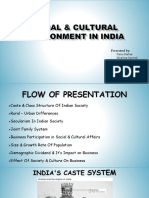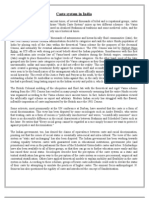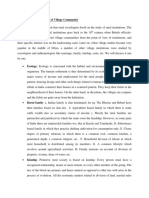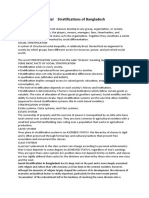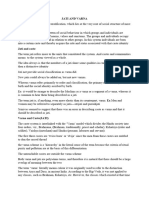Caste System in Nepal
Caste System in Nepal
Uploaded by
akvosmCopyright:
Available Formats
Caste System in Nepal
Caste System in Nepal
Uploaded by
akvosmOriginal Description:
Copyright
Available Formats
Share this document
Did you find this document useful?
Is this content inappropriate?
Copyright:
Available Formats
Caste System in Nepal
Caste System in Nepal
Uploaded by
akvosmCopyright:
Available Formats
Nepalese are known by castes amongst themselves essentially for their identity.
It affects their family life,
food, dress, occupations and culture. Basically, it determines their way of life. On the whole, caste system
has an important role in social stratification in Nepal. There are many castes in Nepal amongst various
communities mainly in the hills, valleys and the plains.
The caste system is divided into four folds which are Brahman (priests and scholars), Kshatriya (warriors),
Vaisya (merchants and traders), and Sudra (laborers). In this system, the membership is both hereditary
and permanent. Inter-caste marriage is almost impossible as it carries a social disgrace, especially when it
takes place between two castes at the extreme ends of the society. Furthermore, caste determines an
individual's behavior, obligations, and expectations. It also determines the limit access to land, position of
political power, and command of human labor. Violating these rules is liable to certain punishment like
social boycott.
The caste of an individual basically determines his ritual status, purity, and pollution. This is the most
mysterious facet of the caste system. The issue of purity and being impure exists not only between higher
and lower castes but also within one’s caste community. A person of higher caste is declared temporarily
impure if his relative/family is dead, if she is going through menstrual period or if she has given birth to a
child. The time period of one being declared temporarily impure is between a week and one year. If declared
impure, such people are kept in a separate place in the house and generally not touched. Likewise, drinking
water and food is declared impure if it has been consumed by another person. Impure food is thrown away
and not consumed. Likewise, people belonging to a lower caste are declared impure for higher caste people
for a lifetime. They are discriminated and the higher caste people need purification or to be sprinkled by holy
water if touched by them.
Likewise, Pollution means that the lower caste is considered polluted and thus not allowed to touch or stay
close to higher caste people. They are also deprived of entering temples, funeral places, restaurants, shop
and other public places. They are also not allowed to utilize public drinking water taps and wells. They are
also barred from entering the homes of higher castes.
The caste system in Nepal was earlier incorporated in the National law in order to incorporate people of
different origin and bring them under an umbrella. Each caste has its set of family names given to the
members of its community according to their professions. The Brahmin and Kshatriya have the highest
status in social hierarchy and so they had access to fertile lands, power and authority. The Vaisyas come
second and they are the ones who do business and gain wealth. The Sudras are the last amongst all and
are called the impure, polluted and untouchables.
With the advent of democracy in 1950, social discriminations started breaking down especially in the major
cities. Caste based discrimination in the public places and government service especially in the cities is
almost extinct, but it still exists in the rural villages. However, with the development of tourism as one of the
major industry, the people in the rural villages have stopped treating the tourists as
untouchables. Moreover, according to the new constitution of Nepal, any discrimination based on castes,
gender or religion and especially the practice of untouchability has been made punishable. It is one of the
cruelest features of the caste system.
The division of society into caste system might have been the result of higher caste unwilling to work on
lower jobs and enforcing weaker, poor, war prisoners and slaves to do this profession. But today due to
lack of work to sustain one’s life, people regardless of their caste work in every sector. On the other hand,
people of lower sections have slowly risen to the higher position with possibility for their advancement or
economic independence, with dignity of their own. Their professions have undergone expansion with the
changing situation.
So, the caste system is slowly being abandoned because it is difficult to practice in the modern society due
to lack of time and development in educational, legal and social awareness. However, it dominated social
reality in ancient Nepal and was the social compulsion of that time. It was once a convenient mean to
integrate a multicultural society into one complex system. Nepal is surely a common garden for its entire
people.
You might also like
- Understanding Personality: The 12 Jungian ArchetypesDocument13 pagesUnderstanding Personality: The 12 Jungian Archetypesdrovoca100% (14)
- Starbucks BaristaDocument3 pagesStarbucks Baristaoscarjcalderonr100% (1)
- Caste Class Gender and Ethnicity As Distinct Categories and Their InterconnectionDocument24 pagesCaste Class Gender and Ethnicity As Distinct Categories and Their InterconnectionSakshi100% (5)
- Dalits in India, Manusmriti and Samkhya PhilosophyFrom EverandDalits in India, Manusmriti and Samkhya PhilosophyRating: 3 out of 5 stars3/5 (2)
- IRC SP 18-1996 Bridges Maintenance Inspection PDFDocument24 pagesIRC SP 18-1996 Bridges Maintenance Inspection PDFakvosmNo ratings yet
- Business Enviornment Ppt-1Document75 pagesBusiness Enviornment Ppt-1VEEERYNo ratings yet
- Caste SystemDocument2 pagesCaste SystemAmmar Abdullah DanialNo ratings yet
- reportKBSaxena PDFDocument309 pagesreportKBSaxena PDFbudimahNo ratings yet
- Caste, Varna and JatiDocument7 pagesCaste, Varna and JatiSuman DasNo ratings yet
- Abiralchand Socio 2022Document6 pagesAbiralchand Socio 2022Abiral ChandNo ratings yet
- Social InstitutionsDocument4 pagesSocial InstitutionsbanaloverlololNo ratings yet
- Caste-Class and Rural-Urban DivideDocument6 pagesCaste-Class and Rural-Urban DivideSanchita GhoshNo ratings yet
- Notes On Tribal IndiaDocument4 pagesNotes On Tribal IndiaTony GuptaNo ratings yet
- Presentation On The Caste System in Ancient IndiaDocument14 pagesPresentation On The Caste System in Ancient IndiaDeeksha DeviNo ratings yet
- ESSAYDocument2 pagesESSAYapolloNo ratings yet
- Unit-2: Themes of Rural Society in India Chapter: - 4 Rural Caste Society in India: - IntroductionDocument11 pagesUnit-2: Themes of Rural Society in India Chapter: - 4 Rural Caste Society in India: - IntroductionDEPARTMENT OF SOCIOLOGY BCWCCNo ratings yet
- Pakistani Society and CultureDocument9 pagesPakistani Society and CulturePernia SanawarNo ratings yet
- Socio-Cultural Dimension of Village Community Introduction: It Is Not Recent That Rural Sociologists Dwell On The Study of Rural Institutions. TheDocument26 pagesSocio-Cultural Dimension of Village Community Introduction: It Is Not Recent That Rural Sociologists Dwell On The Study of Rural Institutions. TheRazor RockNo ratings yet
- Untouchability: How Long Will It Prevail?Document2 pagesUntouchability: How Long Will It Prevail?The Himalayan VoiceNo ratings yet
- CasteDocument3 pagesCasteRaja Sanmanbir SinghNo ratings yet
- Caste System and Concept of Re-IncarnationDocument5 pagesCaste System and Concept of Re-IncarnationMukuka KowaNo ratings yet
- Mobilization and Empowerment of Marginalized Women in South AsiaDocument32 pagesMobilization and Empowerment of Marginalized Women in South AsiaaalsNo ratings yet
- CasteDocument14 pagesCasteMaddila SatishNo ratings yet
- Lesson 2 NOTES Social Mobility and Social InequalityDocument2 pagesLesson 2 NOTES Social Mobility and Social InequalityDaphny SalvaNo ratings yet
- CastesystemsDocument21 pagesCastesystemsNithin NairNo ratings yet
- Features of Caste SystemDocument2 pagesFeatures of Caste Systemjyoti kundu100% (2)
- S2gtGG3NjPzvcpLpuiBv Ic957118Document5 pagesS2gtGG3NjPzvcpLpuiBv Ic957118Akshita SharmaNo ratings yet
- Lecture 23Document8 pagesLecture 23Anonymous dnGsodJ6No ratings yet
- Role of Eduaction in Schools in ReproducDocument7 pagesRole of Eduaction in Schools in ReproducSukhmeet Daljit SinghNo ratings yet
- Mains 2021 Test 5 SolutionsDocument21 pagesMains 2021 Test 5 SolutionsNishat SinghNo ratings yet
- Caste and Class Dynamics in Modern IndiaDocument8 pagesCaste and Class Dynamics in Modern IndiaIqra MerajNo ratings yet
- 03-Ayesha FarooqDocument19 pages03-Ayesha FarooqUsman JanjuaNo ratings yet
- JatiDocument3 pagesJatiPeachy Lyn AmorotoNo ratings yet
- Social Stratifications of BangladeshDocument4 pagesSocial Stratifications of BangladeshShadfazNo ratings yet
- Untouchability Is A Social EvilDocument3 pagesUntouchability Is A Social EvilSHALINI SINGHNo ratings yet
- Document From Rakesh NaskarDocument51 pagesDocument From Rakesh Naskarrakesh naskarNo ratings yet
- Caste Based Discrimination in PakistanDocument2 pagesCaste Based Discrimination in PakistanWaseemAkbarNo ratings yet
- 149) PAPER 2 L15 - Features of Caste SystemDocument5 pages149) PAPER 2 L15 - Features of Caste SystemBhargav RajNo ratings yet
- SCM Sociology Part 2Document18 pagesSCM Sociology Part 2Khushi KhushiNo ratings yet
- Full FMTDocument4 pagesFull FMTmartinsalbethNo ratings yet
- Sociology Project Term 2 FinalDocument26 pagesSociology Project Term 2 Finalriddhika bohraNo ratings yet
- Department of Sociology CC2 Topic - Dominant CasteDocument9 pagesDepartment of Sociology CC2 Topic - Dominant CastedfdsjgsdgfsdNo ratings yet
- Sociology Unit I-VDocument92 pagesSociology Unit I-VLakshayNo ratings yet
- 1 Sociology Assingment of Saqlain Nazir Features of Caste and Caste SystemDocument12 pages1 Sociology Assingment of Saqlain Nazir Features of Caste and Caste SystemsaqlainNo ratings yet
- 3 Social Structure in IndiaDocument15 pages3 Social Structure in IndiaauguimkNo ratings yet
- Indian Society and Social Justice (2022)Document10 pagesIndian Society and Social Justice (2022)Elentia ChhangteNo ratings yet
- Caste and Ethnic Group PDFDocument3 pagesCaste and Ethnic Group PDFuttam shresthaNo ratings yet
- Caste in IndiaDocument32 pagesCaste in Indiapatel13005No ratings yet
- Understanding Social StratificationDocument7 pagesUnderstanding Social StratificationAbhishek KumarNo ratings yet
- Jati - The Caste System PDFDocument4 pagesJati - The Caste System PDFanon_851687296No ratings yet
- JATI AND VARNA SummaryDocument3 pagesJATI AND VARNA SummaryAshishNo ratings yet
- Sociology 3rd Sem PrjectDocument12 pagesSociology 3rd Sem Prjectvikramshantu86047No ratings yet
- Nutritional Eco Status of SahariaDocument7 pagesNutritional Eco Status of SahariaAarushi MahajanNo ratings yet
- JPNR - S09 - 395Document6 pagesJPNR - S09 - 395SakthivelNo ratings yet
- Lecture 23: Caste System in India: Nptel - Humanities and Social Sciences - Introduction To SociologyDocument7 pagesLecture 23: Caste System in India: Nptel - Humanities and Social Sciences - Introduction To Sociologysanju0156No ratings yet
- Caste in IndiaDocument3 pagesCaste in Indianaveen4bhaskarNo ratings yet
- 09 Chapter 1Document73 pages09 Chapter 1Abhijeet desavale0% (1)
- Social Structure in IndiaDocument6 pagesSocial Structure in IndiaAbhijit Jadhav100% (1)
- 2ND Unit 1ST Article by G.S GhuryeDocument16 pages2ND Unit 1ST Article by G.S GhuryePradip kumar yadavNo ratings yet
- Fairfield Institute of Management and Technology: Subject Name: SociologyDocument12 pagesFairfield Institute of Management and Technology: Subject Name: Sociologypoonam swamiNo ratings yet
- Discrimination in India: Different types of Partiality in IndiaFrom EverandDiscrimination in India: Different types of Partiality in IndiaNo ratings yet
- Satellite Castes and Dependent Relations: Dalits in South IndiaFrom EverandSatellite Castes and Dependent Relations: Dalits in South IndiaNo ratings yet
- IRC SP 22-1980 Size of Road Making Machinery PDFDocument13 pagesIRC SP 22-1980 Size of Road Making Machinery PDFakvosmNo ratings yet
- IRC SP 12-1988 Parking Spaces For Urban Area PDFDocument8 pagesIRC SP 12-1988 Parking Spaces For Urban Area PDFakvosmNo ratings yet
- Section 1800 (Flasework, Formwork and Surface Finish For Concrete Structures)Document15 pagesSection 1800 (Flasework, Formwork and Surface Finish For Concrete Structures)akvosmNo ratings yet
- Section 2300 (Timber Construction)Document4 pagesSection 2300 (Timber Construction)akvosmNo ratings yet
- Section 1500 (Traffic Signs, Road Marking, Road Marker Stones and Delineators)Document15 pagesSection 1500 (Traffic Signs, Road Marking, Road Marker Stones and Delineators)akvosmNo ratings yet
- Section 3100 (Miscellaneous Works)Document11 pagesSection 3100 (Miscellaneous Works)akvosmNo ratings yet
- SECTION 700 (Pipe Drains, Pipe Culvert, Concrete Channels)Document9 pagesSECTION 700 (Pipe Drains, Pipe Culvert, Concrete Channels)akvosmNo ratings yet
- Section 2900 (Maintenance Works)Document10 pagesSection 2900 (Maintenance Works)akvosmNo ratings yet
- SECTION 900 (Earthworks)Document22 pagesSECTION 900 (Earthworks)akvosmNo ratings yet
- Analysis of Poem 17 by Jose Garcia VillaDocument2 pagesAnalysis of Poem 17 by Jose Garcia Villadying ib kid82% (83)
- GCU Mission and VisionDocument2 pagesGCU Mission and Visionselina_kollsNo ratings yet
- Assignment On Sexual HarassmentDocument5 pagesAssignment On Sexual HarassmentRohit AnandNo ratings yet
- Callahan, Manuel. Why Not Share A Dream? 2005Document32 pagesCallahan, Manuel. Why Not Share A Dream? 2005aparadise2100% (1)
- Planificare LB - Engleza cls.8 ArtkletDocument7 pagesPlanificare LB - Engleza cls.8 ArtkletAnonymous rQfQJrZRNo ratings yet
- 273 Pocket Theatre Training ActivityDocument1 page273 Pocket Theatre Training Activityxxxxxx100% (1)
- Interpretative ApproachDocument15 pagesInterpretative ApproachNeil RaagasNo ratings yet
- Funda Lecture SG #5Document5 pagesFunda Lecture SG #5Zsyd GelladugaNo ratings yet
- HS Friday Bulletin 10.16.09Document6 pagesHS Friday Bulletin 10.16.09International School ManilaNo ratings yet
- Martha Nussbaum - Human FunctioningDocument46 pagesMartha Nussbaum - Human FunctioningBernardoBrandaoNo ratings yet
- Rhetorical Theory and Criticism - Ass 2 PDFDocument5 pagesRhetorical Theory and Criticism - Ass 2 PDFLuiseNo ratings yet
- Discourse Translation From English To Telugu: August 2015Document6 pagesDiscourse Translation From English To Telugu: August 2015vinod vinodNo ratings yet
- Chapple, R. M. 2014 New Adventures With High Crosses - Clogher, Co. Tyrone. Blogspot PostDocument7 pagesChapple, R. M. 2014 New Adventures With High Crosses - Clogher, Co. Tyrone. Blogspot PostRobert M ChappleNo ratings yet
- Worldview OrishasDocument7 pagesWorldview Orishash6329lopezNo ratings yet
- Ppt. Intro To Esp. Language Variation and Register Analysis. Sem 4Document14 pagesPpt. Intro To Esp. Language Variation and Register Analysis. Sem 4Annastya SalsabilaNo ratings yet
- Sources and Kin-WPS OfficeDocument4 pagesSources and Kin-WPS Officeangelica joyce caballesNo ratings yet
- Irshad Ahmed Thesis CompletDocument45 pagesIrshad Ahmed Thesis CompletAbrar Ahmed KhanNo ratings yet
- Lessons 1-3 Questions Ancient IndiaDocument12 pagesLessons 1-3 Questions Ancient IndiamasNo ratings yet
- Ursala SharmaDocument2 pagesUrsala SharmaAngelina FrancisNo ratings yet
- Text 7 Traditional Jazz DancesDocument9 pagesText 7 Traditional Jazz DancesMonicaMartirosyanNo ratings yet
- Penelopiad Paper OrigionalDocument13 pagesPenelopiad Paper Origionalapi-459377894No ratings yet
- SpeechDocument8 pagesSpeechMark Anthony SagayapNo ratings yet
- White Socks OnlyDocument3 pagesWhite Socks Onlyapi-380702665No ratings yet
- The Roles of Lao Buddhist Sa Gha On Applied Social Work in Lao SocietyDocument9 pagesThe Roles of Lao Buddhist Sa Gha On Applied Social Work in Lao SocietyສຽງທັມVOICENo ratings yet
- Remedies For Forced Marriage A HANDBOOK FOR LAWYERSDocument57 pagesRemedies For Forced Marriage A HANDBOOK FOR LAWYERSAsad Ali KhanNo ratings yet
- 5081 Ijrse final-WikangKulitDocument13 pages5081 Ijrse final-WikangKulitGem ManzonNo ratings yet
- RHS Ap 2211Document48 pagesRHS Ap 2211GeoBlogsNo ratings yet
- Class Management & DisciplineDocument22 pagesClass Management & DisciplineAnwaarNo ratings yet






